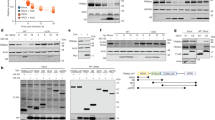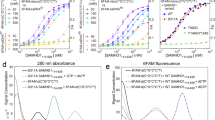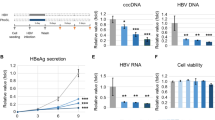Abstract
Human immunodeficiency virus (HIV), the causative agent of AIDS, infects human lymphocytes and monocytes1,2. An interaction between the viral envelope gp120 and CD4 protein is required to initiate an infectious cycle3–7. HIV infection in vitro induces syncytium formation by cell-to-cell fusion; this aspect of viral cytopathogenicity is even more dependent on gp120–CD4 interactions4. That gp120 is extremely heavily glycosylated (31–36 N-linked glycans per molecule), suggests involvement of N-linked glycans in the gp120–CD4 interaction8. We therefore investigated the effects of castanospermine, 1-deoxynojirimycin (dNM) and 1-deoxymannojirimycin (dMM), three trimming glycosidase inhibitors which perturb N-linked glycan structure9, on induction of the formation of syncytium between HIV-infected and CD4-expressing cells. The glucosidase inhibitors castanospermine and dNM, but not the mannosidase inhibitor dMM, inhibited syncytium formation and interfered with infectivity. The potential of glucosidase inhibitors as anti-HIV therapeutic agents deserves further investigation, especially because dNM and related compounds show little toxicity in vitro and in vivo9–11.
This is a preview of subscription content, access via your institution
Access options
Subscribe to this journal
Receive 51 print issues and online access
$199.00 per year
only $3.90 per issue
Buy this article
- Purchase on Springer Link
- Instant access to full article PDF
Prices may be subject to local taxes which are calculated during checkout
Similar content being viewed by others
References
1. Klatzmann, D. et al. Nature 312, 767-768 (1984). 2. Nicholson, J. K. A., Cross, G. D., Callaway, C. S. & McDougal, J. S. J. Immun. 137,323-329 (1986). 3. Klatzmann, D. et al. Science 225, 59-63 (1984). 4. Dalgleish, A. G. et al. Nature 312, 763-766 (1984). 5. Lifson, J. D., Rays, G. R., McGrath, M. S., Stein, B. A. & Engleman, E. G. Science 232, 1123-1127 (1986). 6. Sodroski, J., Goh, W. C., Rosen, C. A., Campbell, K. & Haseltine, W. A. Nature 322, 470-474 (1986). 7. McDougal, J. et al. Science 231, 382-385 (1986). 8. Montagnier, L. et al. Virology 114, 283-289 (1985). 9. Fuhrmann, U., Bause, E. & Ploegh, H. L. Biochim. biophys. Acta 825, 95-110 (1985). 10. Joubert, P. H., Bam, W. J. & Manyane, M. Eur. J. din. Pharmac. 30, 253-255 (1986). 11. Shack, C., Roggla, G., Luger, A. & Schernthaner, G. Eur. J. din. Pharmac. 30,417-419 (1986). 12. Barre-Sinoussi, F. et al. Science 220, 868-871 (1983). 13. Popovic, M., Sarngadharan, M. C., Read, E. & Gallo, R. C. Science 224, 497-500 (1984). 14. Maddon, P. et al. Cell 47, 333-348 (1986). 15. Matthews, T. J. et al. Proc. natn. Acad. Sci. U.S.A. 84, 5424-5428 (1987). 16. Putney, S. et al. Science 234, 1392-1395 (1986). 17. Lifson, J. et al. Nature 323, 725-728 (1986). 18. Tersmette, M., Miedema, F., Huisman, J. G., Goudsmit, J. & Melief, C. J. M. Lancet i, 815-816 (1985). 19. Tersmette, M. et al. J. Immun. (in the press). 20. Petit, A. J. C., Terpstra, F. G. & Miedema, F. /. din. Invest. 79, 1883-1889 (1987).
Author information
Authors and Affiliations
Rights and permissions
About this article
Cite this article
Gruters, R., Neefjes, J., Tersmette, M. et al. Interference with HIV-induced syncytium formation and viral infectivity by inhibitors of trimming glucosidase. Nature 330, 74–77 (1987). https://doi.org/10.1038/330074a0
Received:
Accepted:
Issue Date:
DOI: https://doi.org/10.1038/330074a0
This article is cited by
-
Biological evaluation of 9-(1H-Indol-3-yl) xanthen-4-(9H)-ones derivatives as noncompetitive α-glucosidase inhibitors: kinetics and molecular mechanisms
Structural Chemistry (2019)
-
Pathophysiological implications of mitochondrial oxidative stress mediated by mitochondriotropic agents and polyamines: the role of tyrosine phosphorylation
Amino Acids (2015)
-
Anti-viral activity of blue chanterelle (Polyozellus multiplex) that inhibits α-glucosidase
Food Science and Biotechnology (2013)
-
Synthesis and structure–activity relationships of serotonin derivatives effect on α-glucosidase inhibition
Medicinal Chemistry Research (2012)
-
Bioactive compounds extracted from Gamtae (Ecklonia cava) by using enzymatic hydrolysis, a potent α-glucosidase and α-amylase inhibitor, alleviates postprandial hyperglycemia in diabetic mice
Food Science and Biotechnology (2012)
Comments
By submitting a comment you agree to abide by our Terms and Community Guidelines. If you find something abusive or that does not comply with our terms or guidelines please flag it as inappropriate.



